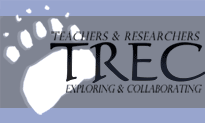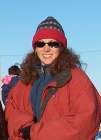 |
|
|
| Author |
Message |
Misty_Nikula-Ohlsen

Joined: 23 Mar 2004
Posts: 74
Location: Barrow, AK

|
 Posted:
Wed Jul 21, 2004 7:57 am Posted:
Wed Jul 21, 2004 7:57 am |
  |
Well, the power generation tower at BEO is working marvelously! We went out to the tower yesterday morning, checked the batteries (28V, yeah!), I downloaded the data for the first time using the sophisticated glare and mosquito blocker as you can see below, and we were done! It was the first time that the walk seemed more significant than the work at the tower.

Me downloading the data under my coat (so I can see the laptop screen)
We spent the afternoon working on odds and ends (and taking naps). Then about 4 pm I met up with Jenny and Marcus for a mini-lesson in GPS. Marcus works for the Michigan State University group here and is a GPS expert (and also Jenny’s boyfriend, but we don’t hold that against her  ). ).
GPS stands for the Global Positioning System and is a method of determining your exact location very precisely using satellites and a receiver. Basically, there are 27 satellites that orbit the earth in very precise orbits. The orbits of these satellites are designed so that at least four are in the sky above any spot on the earth at any given time. The satellites send out a specific patterned digital signal beginning at a specific time, like midnight. Your GPS receiver also produces these same timed signals. The receiver determines the distance to the satellite by the difference in timing between its own signal and the one from the satellite. By detecting its distance from at least four satellites, the GPS receiver can narrow down its location through a process called 3-D trilateration.
To learn more about GPS receivers and how they work check out this link to the How Stuff Works website. It has some good animation of 3-D trilateration, too.
http://electronics.howstuffworks.com/gps.htm
So we set out and took some points around the NARL (like the racquetball court, the north door stairway of the Ilisagvik College building and a truck in the parking lot, very vital locations like that). We had to take the points in a system called UTM, which stands for Universal Transverse Mercator System. It is a system that divides the earth (from 84 N latitude to 80 S latitude) into a grid, using a special kind of projection to convert the spherical earth to a flat map. Each UTM zone is 6 degrees of longitude wide.
Each UTM reading consists of a northing and an easting reading, which is just like an X-Y location on a coordinate grid. The center of the zone from east-west is set as 500,000 meters. Thus as you move more east from the zone center, your easting reading gets larger than 500,000 and as you move west of center, your easting reading gets less than 500,000. The equator is set as 0 for the northern hemisphere, so your northing reading is the number of meters that you are from the equator. For example, the UTM for the racquetball court was 04 582835 E and 7915343 N. The 04 indicates that we are in the fourth UTM zone (numbered from 180 degrees longitude, going east). So we were 82,835 m from the center of zone four and nearly 8 million meters from the equator.

Map of UTM zones (From http://www.dmap.co.uk/utmworld.htm)
The advantages to the UTM system are that it is strictly in meters and you can simply take the difference between readings (and maybe use the Pythagorean Theorem) to find a distance. Also it is an orthogonal system, meaning that all of the “lines” of the system are at right angles to one another. Neither of these things is true in lat-long coordinates, which are spherically based. One degree of longitude is not always the same distance on the earth (compare the distance between 0 degrees and 10 degrees West at the equator versus near the poles). Also the angles between the lines of latitude and longitude are not at right angles, especially as you get closer to the poles.
You can learn more about the UTM system and its origin on this webpage (though it is a fairly complicated explanation):
http://www.cnr.colostate.edu/class_info/nr502/lg3/datums_coordinates/utm.html
After we had our points marked on our GPS units, we went into the lab and Marcus helped us input the points into ArcMap, which is a Geographic Information System (GIS) program. These programs allow you to put information on different overlapping “layers” by topic or purpose. For example, you could have a GIS map of Bellingham that had one layer that showed the city water system, one that showed public streets and another that showed fire hydrants. The layers would be transparent so that you could see all of these pieces of information at the same time on a very precise grid because they are specific to their UTM location. In fact, if you had a copy of ArcMap, or some other similar GIS software, you could download and look at GIS files from the Internet for Bellingham at:
http://www.cob.org/cobweb/pw/eng/gis/index.htm
If you don’t live in Bellingham, your own home town may have a similar website. See if you can find it!
Last night we went to the Inupiat Heritage Center to see a presentation made by two Swedish scientists who will be working on the Swedish icebreaker Oden next summer. The Oden will be taking a three leg voyage across the Arctic Ocean over the course of 3-4 months next Spring/Summer to allow access for various groups of scientists to remote locations throughout the Arctic. The expedition is called Beringia 2005. Beringia is the continuous landmass that extended from approximately the Mackenzie River in Canada to the Lena River in Siberia. It includes the Bering Land Bridge which first existed 70 million years ago and was uncovered for most of the past 2 million years until is was submerged about 11,000 years ago. It was very large and is an important area of study for several reasons, including that it is the only unglaciated part of the Arctic. The scientists aboard the Oden will be studying the Arctic as well as land areas around both the Russian and Alaskan sides of the Bering Strait. You can learn more about their expedition at:
http://www.polar.se/english/expeditions/beringia2005/
Today we did part of the field work at CMDL again. I did soil moisture, while Kirstin did thaw depth. Jenny went to BEO, where all was well again, and then helped us finish up after lunch.

Looking back toward CMDL and the eddy tower from the end of the East transect (can you find Kirstin?)
I spent the afternoon working on the data from CMDL, processing the soil moisture data and working out at the gym. After dinner, we dropped Kirstin off at the airport, where she is flying St Louis, MO to attend her brother’s wedding, and went to another science talk at the Heritage Center. This one was presented by a group from the Canadian Coast Guard Icebreaker, the Sir Wilfrid Laurier. First, two officers from the Canadian Coast Guard told us about the operations of the vessel and their accomplishments from last summer. The icebreaker clears shipping lanes in the winter and works as a scientific platform in the Arctic in the summer. Then two of the scientists from onboard the icebreaker presented some of their findings from the research that they have done in the Bering Strait and in the Northern Canadian Arctic. Tomorrow, they will be giving tours of the icebreaker! Stay tuned for more information and pictures! |
|
|
     |
 |
|
|
|
View next topic
View previous topic
You cannot post new topics in this forum
You cannot reply to topics in this forum
You cannot edit your posts in this forum
You cannot delete your posts in this forum
You cannot vote in polls in this forum
You cannot attach files in this forum
You can download files in this forum
|
Powered by phpBB 2.0.11
© 2001, 2002 phpBB Group :: FI Theme ::
All times are GMT
| |
